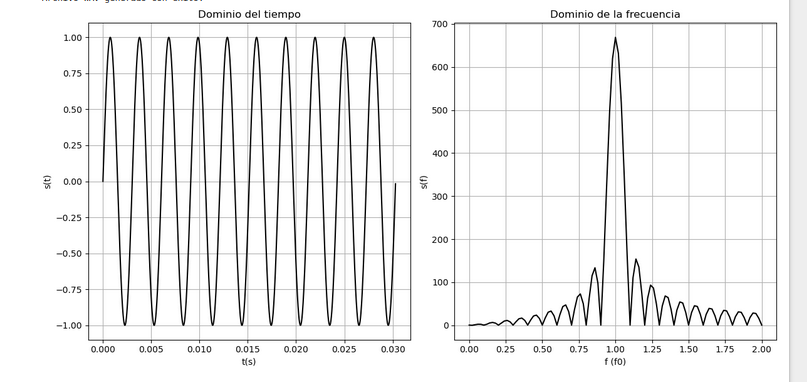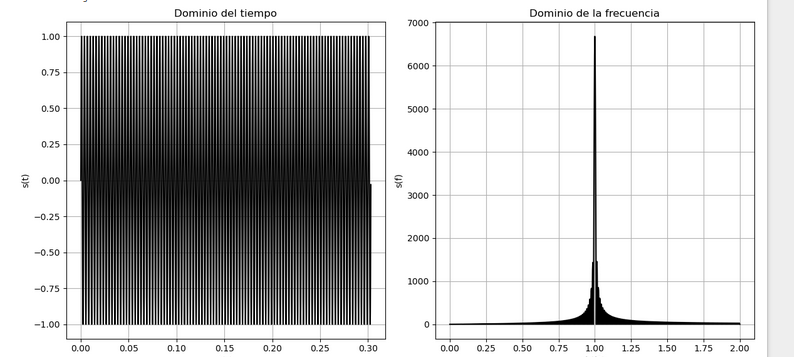Categoría: Uncategorized
Protegido: tercer modo
Protegido: segundo modo (continua)
Protegido: Analisi del primer modo guiado
Protegido: Modeling endface (continua)
shirped
import numpy as np
from scipy.io.wavfile import write
import math
import matplotlib.pyplot as plt
from scipy.signal import stft
from scipy.fft import fft, fftfreq
## PARAMETROS DE LA SENIAL
amplitud = 32767 # Amplitud máxima (para 16-bit PCM)
fs = 44100 # Frecuencia de muestreo en Hz (común para audio de alta calidad)
ts = 1/fs
## PARAMETROS DE LA SENIAL
f0 = 330
t0 = 1/f0
ti = 0.0
tf = 30*t0
Nt = int((tf-ti)*fs)
t = np.zeros(Nt+1)
st = np.zeros(Nt+1)
fsignal = np.zeros(Nt+1)
fsignal_i = 0.5*f0
fsignal_f = 1.5*f0
dsignal = (fsignal_f-fsignal_i)/Nt
for it in range(Nt+1):
t[it] = ti+it*ts
fsignal[it] = fsignal_i+it*dsignal
st[it] = math.sin(2.0*math.pi*fsignal[it]*t[it])
# archivo wav
senal = amplitud*st
senal_int16 = np.int16(senal)
write("senal_sinusoidal.wav", fs, senal_int16)
print("Archivo WAV generado con éxito.")
# Zero-padding: Agregar ceros para aumentar la resolución
n_padded = 20096 # Número de puntos para la DFT (aumenta la resolución)
signal_padded = np.pad(st, (0, n_padded - len(st)), 'constant')
# Calcular la DFT
fft_values = fft(signal_padded)
fft_freqs = fftfreq(len(fft_values), 1/fs)
frequencies, times, Zxx = stft(st, fs=fs, nperseg=556)
plt.figure(figsize=(12, 6))
plt.subplot(2,2,1)
plt.plot(t,fsignal)
plt.xlabel('Tiempo (s)')
plt.ylabel('f(t)')
plt.grid()
plt.subplot(2, 2, 2)
plt.plot(t,st)
plt.xlabel('Tiempo (s)')
plt.ylabel('s(t)')
#plt.xlabel('Tiempo (s)')
plt.subplot(2, 2, 3)
plt.plot( np.abs(fft_values)[:len(fft_values)//2], fft_freqs[:len(fft_values)//2],'r')
#plt.title("Transformada Discreta de Fourier (DFT)")
plt.ylabel("Frecuencia (Hz)")
plt.xlabel("Magnitud")
plt.ylim([200,800])
plt.grid()
plt.subplot(2,2,4)
plt.pcolormesh(times, frequencies, np.abs(Zxx), shading='gouraud')
#plt.colorbar(label='Magnitud')
#plt.title('STFT de la Señal Sinusoidal de 330 Hz')
#plt.ylabel('Frecuencia (Hz)')
plt.xlabel('Tiempo (s)')
plt.ylim(200, 800) # Limitar el rango de frecuencias
plt.grid()
plt.pcolormesh(times, frequencies, np.abs(Zxx), shading='gouraud')
plt.subplots_adjust(hspace=0.4)
plt.show()

import numpy as np
from scipy.io.wavfile import write
import math
import matplotlib.pyplot as plt
## PARAMETROS DE LA SENIAL
amplitud = 32767 # Amplitud máxima (para 16-bit PCM)
fs = 44100 # Frecuencia de muestreo en Hz (común para audio de alta calidad)
ts = 1/fs
## PARAMETROS DE LA SENIAL
f0 = 330
t0 = 1/f0
ti = 0.0
tf = 10*t0
Nt = int((tf-ti)*fs)
t = np.zeros(Nt+1)
st = np.zeros(Nt+1)
fsignal = np.zeros(Nt+1)
fsignal_i = 0.5*f0
fsignal_f = 1.5*f0
dsignal = (fsignal_f-fsignal_i)/Nt
for it in range(Nt+1):
t[it] = ti+it*ts
fsignal[it] = fsignal_i+it*dsignal
st[it] = math.sin(2.0*math.pi*fsignal[it]*t[it])
plt.plot(t,st,'b')
plt.grid()
plt.show()
senal = amplitud*st
senal_int16 = np.int16(senal)
write("senal_sinusoidal.wav", fs, senal_int16)
print("Archivo WAV generado con éxito.")
Transfromada de fourier de pulso corto (con libreria)
import numpy as np
from scipy.io.wavfile import write
import math
import matplotlib.pyplot as plt
## PARAMETROS DE LA SENIAL
amplitud = 32767 # Amplitud máxima (para 16-bit PCM)
fs = 44100 # Frecuencia de muestreo en Hz (común para audio de alta calidad)
ts = 1/fs
## PARAMETROS DE LA SENIAL
f0 = 330
t0 = 1/f0
ti = 0.0
tf = 20*t0
Nt = int((tf-ti)*fs)
t = np.zeros(Nt+1)
st = np.zeros(Nt+1)
for it in range(Nt+1):
t[it] = ti+it*ts
st[it] = math.sin(2.0*math.pi*f0*t[it])
plt.plot(t,st,'b')
plt.grid()
plt.show()
senal = amplitud*st
senal_int16 = np.int16(senal)
write("senal_sinusoidal.wav", fs, senal_int16)
print("Archivo WAV generado con éxito.")

import numpy as np
from scipy.io.wavfile import write
import math
import matplotlib.pyplot as plt
from scipy.signal import stft
from scipy.fft import fft, fftfreq
## PARAMETROS DE LA SENIAL
amplitud = 32767 # Amplitud máxima (para 16-bit PCM)
fs = 44100 # Frecuencia de muestreo en Hz (común para audio de alta calidad)
ts = 1/fs
## PARAMETROS DE LA SENIAL
f0 = 330
t0 = 1/f0
ti = 0.0
tf = 20*t0
Nt = int((tf-ti)*fs)
t = np.zeros(Nt+1)
st = np.zeros(Nt+1)
for it in range(Nt+1):
t[it] = ti+it*ts
st[it] = math.sin(2.0*math.pi*f0*t[it])
# Zero-padding: Agregar ceros para aumentar la resolución
n_padded = 20096 # Número de puntos para la DFT (aumenta la resolución)
signal_padded = np.pad(st, (0, n_padded - len(st)), 'constant')
# Calcular la DFT
fft_values = fft(signal_padded)
fft_freqs = fftfreq(len(fft_values), 1/fs)
frequencies, times, Zxx = stft(st, fs=fs, nperseg=2256)
plt.pcolormesh(times, frequencies, np.abs(Zxx), shading='gouraud')
plt.colorbar(label='Magnitud')
plt.title('STFT de la Señal Sinusoidal de 330 Hz')
plt.ylabel('Frecuencia (Hz)')
plt.xlabel('Tiempo (s)')
plt.ylim(0, 600) # Limitar el rango de frecuencias
plt.grid()
plt.show()
senal = amplitud*st
senal_int16 = np.int16(senal)
write("senal_sinusoidal.wav", fs, senal_int16)
print("Archivo WAV generado con éxito.")

plt.plot(fft_freqs[:len(fft_values)//2], np.abs(fft_values)[:len(fft_values)//2], 'r')
plt.title("Transformada Discreta de Fourier (DFT)")
plt.xlabel("Frecuencia (Hz)")
plt.ylabel("Magnitud")
plt.xlim([0,600])
plt.grid()

plt.figure(figsize=(12, 6))
plt.subplot(2, 2, 2)
plt.plot(t,st)
#plt.xlabel('Tiempo (s)')
plt.subplot(2, 2, 3)
plt.plot( np.abs(fft_values)[:len(fft_values)//2], fft_freqs[:len(fft_values)//2],'r')
#plt.title("Transformada Discreta de Fourier (DFT)")
plt.ylabel("Frecuencia (Hz)")
plt.xlabel("Magnitud")
plt.ylim([0,600])
plt.grid()
plt.subplot(2,2,4)
plt.pcolormesh(times, frequencies, np.abs(Zxx), shading='gouraud')
#plt.colorbar(label='Magnitud')
#plt.title('STFT de la Señal Sinusoidal de 330 Hz')
#plt.ylabel('Frecuencia (Hz)')
plt.xlabel('Tiempo (s)')
plt.ylim(0, 600) # Limitar el rango de frecuencias
plt.grid()
plt.pcolormesh(times, frequencies, np.abs(Zxx), shading='gouraud')

La transfromada de fourier (biblioteca)
import numpy as np
from scipy.io.wavfile import write
import math
import matplotlib.pyplot as plt
## PARAMETROS DE LA SENIAL
amplitud = 32767 # Amplitud máxima (para 16-bit PCM)
fs = 44100 # Frecuencia de muestreo en Hz (común para audio de alta calidad)
ts = 1/fs
## PARAMETROS DE LA SENIAL
f0 = 330
t0 = 1/f0
ti = 0.0
tf = 10*t0
Nt = int((tf-ti)*fs)
t = np.zeros(Nt+1)
st = np.zeros(Nt+1)
for it in range(Nt+1):
t[it] = ti+it*ts
st[it] = math.sin(2.0*math.pi*f0*t[it])
plt.plot(t,st,'b')
plt.grid()
plt.show()
senal = amplitud*st
senal_int16 = np.int16(senal)
write("senal_sinusoidal.wav", fs, senal_int16)
print("Archivo WAV generado con éxito.")
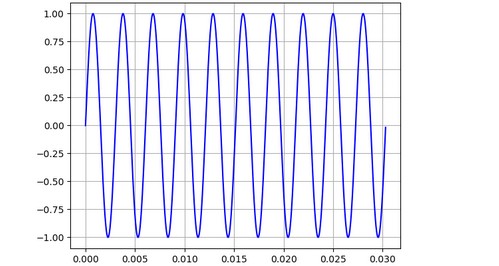
import numpy as np
from scipy.io.wavfile import write
import math
import matplotlib.pyplot as plt
from scipy.fft import fft, fftfreq
## PARAMETROS DE LA SENIAL
amplitud = 32767 # Amplitud máxima (para 16-bit PCM)
fs = 44100 # Frecuencia de muestreo en Hz (común para audio de alta calidad)
ts = 1/fs
## PARAMETROS DE LA SENIAL
f0 = 330
t0 = 1/f0
ti = 0.0
tf = 10*t0
Nt = int((tf-ti)*fs)
t = np.zeros(Nt+1)
st = np.zeros(Nt+1)
for it in range(Nt+1):
t[it] = ti+it*ts
st[it] = math.sin(2.0*math.pi*f0*t[it])
fft_values = fft(st)
fft_freqs = fftfreq(len(fft_values), 1/fs)
# Graficar la señal original
plt.figure(figsize=(12, 6))
plt.subplot(2, 1, 1)
plt.plot(t, st, 'b')
plt.title("Señal Sinusoidal de 330 Hz")
plt.xlabel("Tiempo (s)")
plt.ylabel("Amplitud")
plt.grid()
# Graficar la magnitud de la DFT
plt.subplot(2, 1, 2)
plt.plot(fft_freqs[:len(fft_values)//2], np.abs(fft_values)[:len(fft_values)//2], 'r')
plt.title("Transformada Discreta de Fourier (DFT)")
plt.xlabel("Frecuencia (Hz)")
plt.ylabel("Magnitud")
plt.grid()
plt.tight_layout()
plt.show()
senal = amplitud*st
senal_int16 = np.int16(senal)
write("senal_sinusoidal.wav", fs, senal_int16)
print("Archivo WAV generado con éxito.")
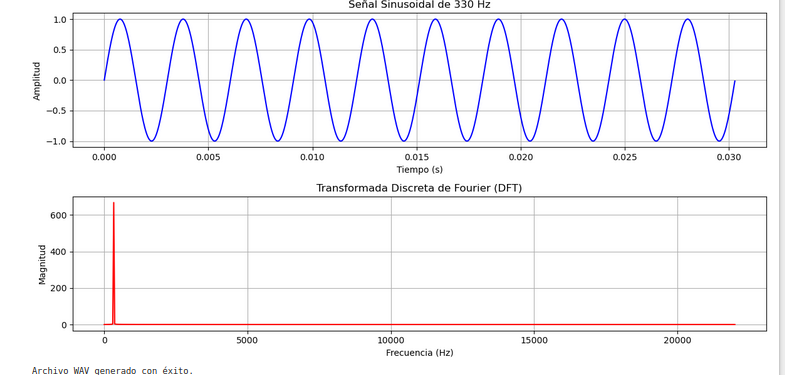
import numpy as np
from scipy.io.wavfile import write
import math
import matplotlib.pyplot as plt
from scipy.fft import fft, fftfreq
## PARAMETROS DE LA SENIAL
amplitud = 32767 # Amplitud máxima (para 16-bit PCM)
fs = 44100 # Frecuencia de muestreo en Hz (común para audio de alta calidad)
ts = 1/fs
## PARAMETROS DE LA SENIAL
f0 = 330
t0 = 1/f0
ti = 0.0
tf = 10*t0
Nt = int((tf-ti)*fs)
t = np.zeros(Nt+1)
st = np.zeros(Nt+1)
for it in range(Nt+1):
t[it] = ti+it*ts
st[it] = math.sin(2.0*math.pi*f0*t[it])
# Zero-padding: Agregar ceros para aumentar la resolución
n_padded = 20096 # Número de puntos para la DFT (aumenta la resolución)
signal_padded = np.pad(st, (0, n_padded - len(st)), 'constant')
# Calcular la DFT
fft_values = fft(signal_padded)
fft_freqs = fftfreq(len(fft_values), 1/fs)
# Graficar la señal original
plt.figure(figsize=(12, 6))
plt.subplot(2, 1, 1)
plt.plot(t, st, 'b')
plt.title("Señal Sinusoidal de 330 Hz")
plt.xlabel("Tiempo (s)")
plt.ylabel("Amplitud")
plt.grid()
# Graficar la magnitud de la DFT
plt.subplot(2, 1, 2)
plt.plot(fft_freqs[:len(fft_values)//2], np.abs(fft_values)[:len(fft_values)//2], 'r')
plt.title("Transformada Discreta de Fourier (DFT)")
plt.xlabel("Frecuencia (Hz)")
plt.ylabel("Magnitud")
plt.xlim([0,600])
plt.grid()
plt.tight_layout()
plt.show()
senal = amplitud*st
senal_int16 = np.int16(senal)
write("senal_sinusoidal.wav", fs, senal_int16)
print("Archivo WAV generado con éxito.")

STFT (home made)
Consideremos el analisis

Una buena explicacion del metodo viene en
https://en.wikipedia.org/wiki/Short-time_Fourier_transform
import numpy as np
from scipy.io.wavfile import write
import math
import matplotlib.pyplot as plt
## PARAMETROS DE LA SENIAL
amplitud = 32767 # Amplitud máxima (para 16-bit PCM)
fs = 44100 # Frecuencia de muestreo en Hz (común para audio de alta calidad)
ts = 1/fs
## PARAMETROS DE LA SENIAL
f0 = 330
t0 = 1/f0
ti = 0.0
tf = 10*t0
Nt = int((tf-ti)*fs)
t = np.zeros(Nt+1)
st = np.zeros(Nt+1)
w = np.zeros(Nt+1)
tau = 0.7*tf
B = 3*t0
for it in range(Nt+1):
t[it] = ti+it*ts
st[it] = math.sin(2.0*math.pi*f0*t[it])
if t[it] > tau-0.5*B and t[it]<tau+0.5*B:w[it]=1.0
plt.plot(t,st,'b')
plt.plot(t,w,'r')
plt.plot(t,st*w,'k')
plt.grid()
plt.show()
senal = amplitud*st
senal_int16 = np.int16(senal)
write("senal_sinusoidal.wav", fs, senal_int16)
print("Archivo WAV generado con éxito.")
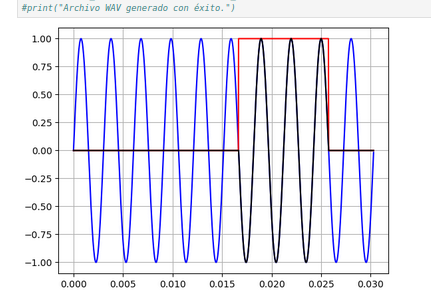
Nf = 100 f = np.zeros(Nf+1) sfr = np.zeros(Nf+1) sfi = np.zeros(Nf+1) sf = np.zeros(Nf+1) fi = 0.0 ff = 2.0*f0 df = (ff-fi)/Nf for iff in range(Nf+1): f[iff] = fi + iff*df for it in range(Nt+1): sfr[iff] = sfr[iff]+st[it]*w[it]*math.cos(2.0*math.pi*f[iff]*t[it]) sfi[iff] = sfi[iff]+st[it]*w[it]*math.sin(2.0*math.pi*f[iff]*t[it]) sf[iff] = math.sqrt( sfr[iff]**2 + sfi[iff]**2 ) plt.plot(f,sf) plt.grid()
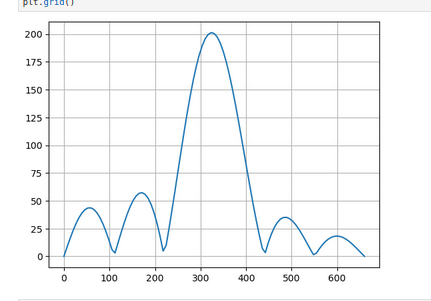
taui = 0.0*tf tauf = 1.0*tf Ntau = Nt dtau = (tauf-taui)/Ntau tauV = np.zeros(Ntau+1) w = np.zeros((Nt+1,Ntau+1)) B = 6*t0 for itau in range(Ntau+1): tauV[itau] = taui+itau*dtau for it in range(Nt+1): if t[it] > tauV[itau]-0.5*B and t[it]<tauV[itau]+0.5*B:w[it,itau]=1.0 plt.plot(t,w[:,550],'b') plt.plot(t,w[:,651],'r') plt.plot(t,w[:,752],'g')
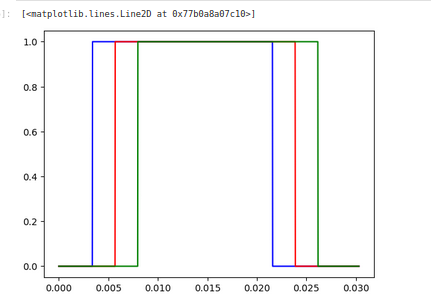
stftr = np.zeros((Nf+1,Ntau+1)) stfti = np.zeros((Nf+1,Ntau+1)) stft = np.zeros((Nf+1,Ntau+1)) fi = 0.0 ff = 2.0*f0 df = (ff-fi)/Nf for itau in range(Ntau+1): for iff in range(Nf+1): f[iff] = fi + iff*df for it in range(Nt+1): stftr[iff,itau] = stftr[iff,itau]+st[it]*w[it,itau]*math.cos(2.0*math.pi*f[iff]*t[it]) stfti[iff,itau] = stfti[iff,itau]+st[it]*w[it,itau]*math.sin(2.0*math.pi*f[iff]*t[it]) stft[iff,itau] = math.sqrt( stftr[iff,itau]**2 + stfti[iff,itau]**2 )
plt.pcolormesh(tauV, f, np.abs(stft), shading='gouraud')

from matplotlib.gridspec import GridSpec
# Crear figura
fig = plt.figure(figsize=(10, 10))
gs = GridSpec(2, 2, height_ratios=[1, 1], width_ratios=[1, 2]) # Ajusta la relación de anchos
# Subpanel superior derecho
ax1 = fig.add_subplot(gs[0, 1]) # 2 filas, 2 columnas, segundo panel
ax1.plot(t, st, 'b')
ax1.set_title("Señal en el Tiempo")
ax1.set_xlabel("Tiempo (s)")
ax1.set_ylabel("Amplitud")
# Subpanel inferior derecho
ax2 = fig.add_subplot(gs[1, 0]) # 2 filas, 2 columnas, tercer panel
ax2.plot( -1*sf,f, 'b')
ax2.set_title("Gráfica de -sw")
ax2.set_xlabel("Valor Negativo")
ax2.set_ylabel("Frecuencia")
# Subpanel inferior izquierdo con imshow
ax3 = fig.add_subplot(gs[1, 1]) # Ocupa toda la columna izquierda
#cax = ax3.imshow(stft, cmap='viridis', interpolation='nearest')
cax = ax3.pcolormesh(tauV, f, np.abs(stft), shading='gouraud')
ax3.set_title("STFT")
ax3.set_xlabel("tiempo")
ax3.set_ylabel("frecuencia")
# fig.colorbar(cax, ax=ax3) # Agregar barra de color si es necesario
plt.tight_layout()
plt.show()

DFT (home made)
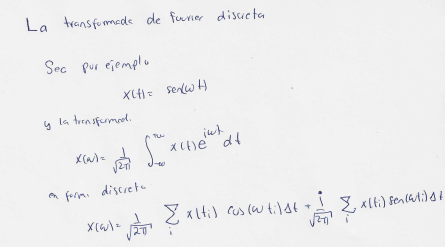
import numpy as np
import math
import matplotlib.pyplot as plt
from scipy.io.wavfile import write
# -> Parámetros de la señal
fs = 44100 # frecuencia de muestreo
ts = 1/fs
amplitud = 32767 # Amplitud máxima (para 16-bit PCM)
# -> Parámetros de la señal
f0 = 330 # Frecuencia en Hz (Ejemplo: 440 Hz corresponde a la nota A4)
t0 = 1/f0
ti = 0.0*t0
tf = 10*t0
Nt = int((tf-ti)*fs)
t = np.zeros(Nt+1)
st = np.zeros(Nt+1)
for it in range(Nt+1):
t[it] = ti+it*ts
st[it] = math.sin(2.0*math.pi*f0*t[it])
######### -> GENERA WAV
senal_int16 = np.int16(amplitud*st)
# Guardar el archivo WAV
write("aux.wav", fs, senal_int16)
print("Archivo WAV generado con éxito.")
######### -> GENERA WAV
Nf = 100
fi = 0.0*f0
ff = 2.0*f0
df = (ff-fi)/Nf
f = np.zeros(Nf+1)
sfr = np.zeros(Nf+1)
sfi = np.zeros(Nf+1)
sf = np.zeros(Nf+1)
for ic in range(Nf+1):
f[ic] = fi+ic*df
for it in range(Nt+1):
sfr[ic] = sfr[ic] + math.cos(2.0*math.pi*f0*t[it])*math.cos(2.0*math.pi*f[ic]*t[it])
sfi[ic] = sfi[ic] + math.cos(2.0*math.pi*f0*t[it])*math.sin(2.0*math.pi*f[ic]*t[it])
sf = np.sqrt(sfr**2+sfi**2)
# Graficar la señal original
plt.figure(figsize=(12, 6))
plt.subplot(1, 2, 1)
plt.plot(t , st, 'k')
plt.title('Dominio del tiempo')
plt.xlabel('t(s)')
plt.ylabel('s(t)')
plt.grid()
# Graficar la magnitud de la transformada de Fourier
plt.subplot(1, 2, 2)
plt.plot(f/f0,sf, 'k')
plt.title('Dominio de la frecuencia')
plt.xlabel('f (f0)')
plt.ylabel('s(f)')
plt.grid()
plt.tight_layout()
plt.show()
